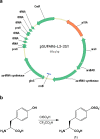Efficient expression of tyrosine-sulfated proteins in E. coli using an expanded genetic code
- PMID: 20010929
- PMCID: PMC2928070
- DOI: 10.1038/nprot.2009.188
Efficient expression of tyrosine-sulfated proteins in E. coli using an expanded genetic code
Abstract
Tyrosine sulfation is an important post-translational modification that occurs in higher eukaryotes and is involved in cell-cell communication, viral entry and adhesion. We describe a protocol for the heterologous expression of selectively tyrosine-sulfated proteins in Escherichia coli through the use of an expanded genetic code that co-translationally inserts sulfotyrosine in response to the amber nonsense codon, TAG. The components required for this process, an orthogonal aminoacyl-tRNA synthetase specific for sulfotyrosine and its cognate orthogonal tRNA that recognizes the amber codon, are encoded on the plasmid pSUPAR6-L3-3SY, and their use, along with a simple chemical synthesis of sulfotyrosine, are outlined in this protocol. Specifically, the gene for a protein of interest is mutated such that the codon corresponding to the desired location of tyrosine sulfate is TAG. Co-transformation of an expression vector containing this gene and pSUPAR6-L3-3SY into an appropriate E. coli strain allows the overexpression of the site-specifically sulfated protein with high efficiency and fidelity. The resulting protein contains tyrosine sulfate at any location specified by a TAG codon, making this method significantly simpler and more versatile than competing methods such as in vitro enzymatic sulfation, chemical sulfation and peptide synthesis. Once the proper expression vectors are cloned, our protocol should allow the production of the desired sulfated proteins in <1 week.
Figures


Similar articles
-
Site-Specific Incorporation of Sulfotyrosine Using an Expanded Genetic Code.Methods Mol Biol. 2018;1728:191-200. doi: 10.1007/978-1-4939-7574-7_12. Methods Mol Biol. 2018. PMID: 29404999
-
Recombinant expression of selectively sulfated proteins in Escherichia coli.Nat Biotechnol. 2006 Nov;24(11):1436-40. doi: 10.1038/nbt1254. Epub 2006 Oct 29. Nat Biotechnol. 2006. PMID: 17072302
-
Genetically encoded protein sulfation in mammalian cells.Nat Chem Biol. 2020 Apr;16(4):379-382. doi: 10.1038/s41589-020-0493-1. Epub 2020 Mar 16. Nat Chem Biol. 2020. PMID: 32198493 Free PMC article.
-
Site-Specific Incorporation of Unnatural Amino Acids into Escherichia coli Recombinant Protein: Methodology Development and Recent Achievement.Biomolecules. 2019 Jun 28;9(7):255. doi: 10.3390/biom9070255. Biomolecules. 2019. PMID: 31261745 Free PMC article. Review.
-
Engineering the Genetic Code in Cells and Animals: Biological Considerations and Impacts.Acc Chem Res. 2017 Nov 21;50(11):2767-2775. doi: 10.1021/acs.accounts.7b00376. Epub 2017 Oct 6. Acc Chem Res. 2017. PMID: 28984438 Free PMC article. Review.
Cited by
-
Identification of permissive amber suppression sites for efficient non-canonical amino acid incorporation in mammalian cells.Nucleic Acids Res. 2021 Jun 21;49(11):e62. doi: 10.1093/nar/gkab132. Nucleic Acids Res. 2021. PMID: 33684219 Free PMC article.
-
Homodimerized cytoplasmic domain of PD-L1 regulates its complex glycosylation in living cells.Commun Biol. 2022 Aug 30;5(1):887. doi: 10.1038/s42003-022-03845-4. Commun Biol. 2022. PMID: 36042378 Free PMC article.
-
Genetically encoding phosphotyrosine and its nonhydrolyzable analog in bacteria.Nat Chem Biol. 2017 Aug;13(8):845-849. doi: 10.1038/nchembio.2405. Epub 2017 Jun 12. Nat Chem Biol. 2017. PMID: 28604693 Free PMC article.
-
Sulfated CXCR3 Peptide Trap Use as a Promising Therapeutic Approach for Age-Related Macular Degeneration.Biomedicines. 2024 Jan 22;12(1):241. doi: 10.3390/biomedicines12010241. Biomedicines. 2024. PMID: 38275412 Free PMC article.
-
Processing of a plant peptide hormone precursor facilitated by posttranslational tyrosine sulfation.Proc Natl Acad Sci U S A. 2022 Apr 19;119(16):e2201195119. doi: 10.1073/pnas.2201195119. Epub 2022 Apr 11. Proc Natl Acad Sci U S A. 2022. PMID: 35412898 Free PMC article.
References
-
- Moore KL. The biology and enzymology of protein tyrosine O-sulfation. J Biol Chem. 2003;278:24243–24246. - PubMed
-
- Seibert C, Sakmar TP. Toward a framework for sulfoproteomics: Synthesis and characterization of sulfotyrosine-containing peptides. Biopolymers. 2008;90:459–477. - PubMed
-
- Kehoe JW, Bertozzi CR. Tyrosine sulfation: a modulator of extracellular protein-protein interactions. Chem Biol. 2000;7:R57–61. - PubMed
-
- Preobrazhensky AA, et al. Monocyte chemotactic protein-1 receptor CCR2B is a glycoprotein that has tyrosine sulfation in a conserved extracellular N-terminal region. J Immunol. 2000;165:5295–5303. - PubMed
-
- Somers WS, Tang J, Shaw GD, Camphausen RT. Insights into the molecular basis of leukocyte tethering and rolling revealed by structures of P- and E-selectin bound to SLe(X) and PSGL-1. Cell. 2000;103:467–479. - PubMed
Publication types
MeSH terms
Substances
Grants and funding
LinkOut - more resources
Full Text Sources
Other Literature Sources

